NISSAN 300ZX 1984 Z31 Brake System Workshop Manual
Manufacturer: NISSAN, Model Year: 1984, Model line: 300ZX, Model: NISSAN 300ZX 1984 Z31Pages: 21, PDF Size: 0.54 MB
Page 1 of 21
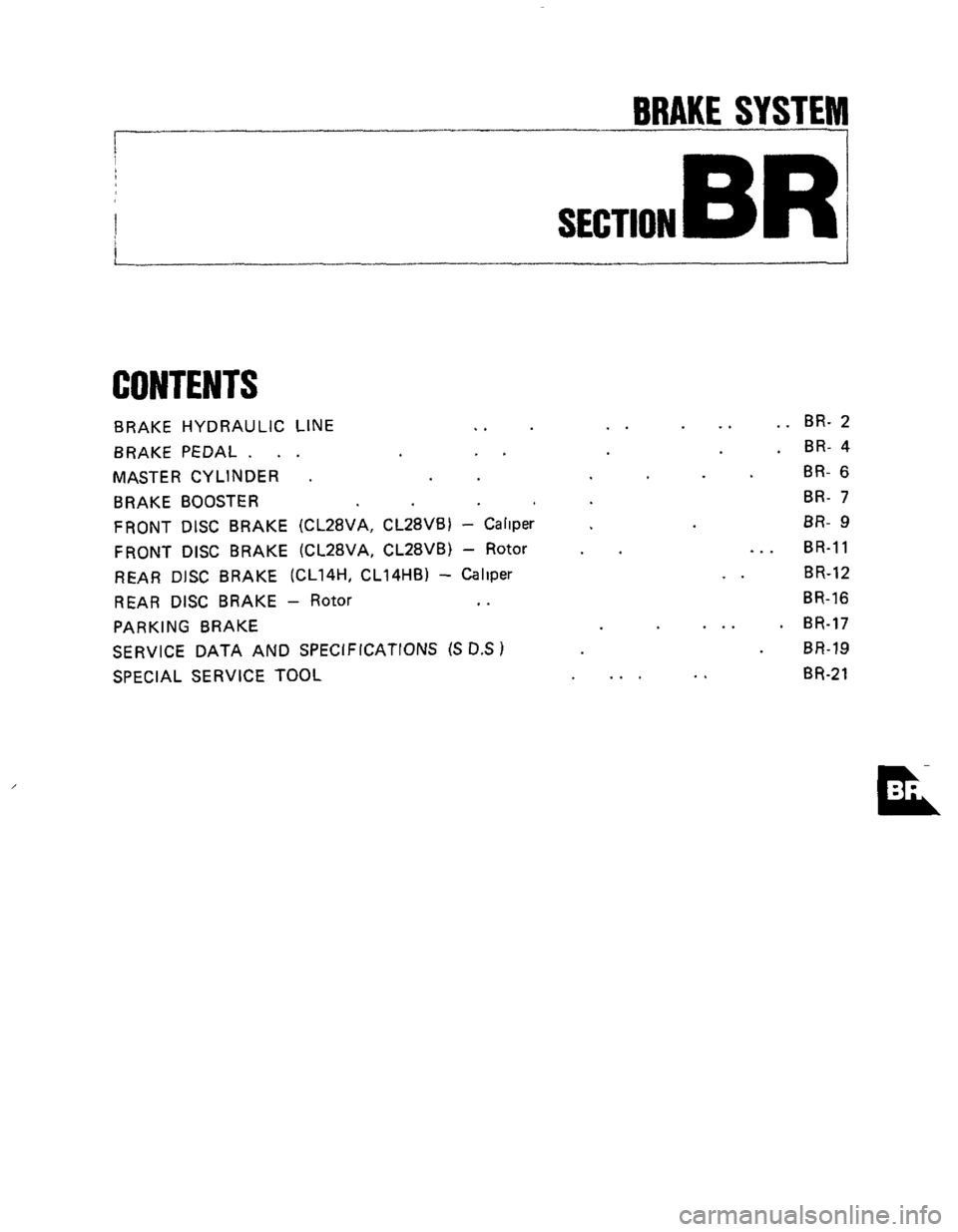
BRAKE SYSTEM
P 7- I
SECTION BR
CONTENTS
BRAKE HYDRAULIC LINE ..
BRAKE PEDAL. . . ..
MASTER CYLINDER .
BRAKE BOOSTER
FRONT DISC BRAKE (CL28VA, CL28VB) - Rotor
REAR DISC BRAKE (CL14H, CL14HB) - Callper
PARKING BRAKE
SERVICE DATA AND SPECIFICATIONS
6 D.S)
SPECIAL SERVICE TOOL
FRONT DISC BRAKE (CL28VA, CL28VB) - Caliper
REAR DISC BRAKE - Rotor ..
.. .. .. BR- 2
. BR- 4
BR- 6
BR- 7
BR- 9
. . . BR-11
.. BR-12
BR-16
. .. . BR-17
. BR-19
.. . .. BR-21
Page 2 of 21

BRAKE HYDRAULIC LINE
rn Recommended fluid is brake fluid "DOT 3".
Do not reuse drained brake fluid
Be careful not to splash brake fluid on painted areas
Front brake lCL28VA. CL28VB)
rFlare nut
7
7
Rear brake lCL14H. CL14HB)
7 0 15- 18 I1 5- 18.11.131
@@.A
Three-way connector I1 5. 1 8, 11 - 131
Flare nut 15-18 I1 5- 18.11 -13)
\Flare nut
0 15.18 I1 5.18.11.13)
WARNING
Clean pad and shoe dust using a dust
collector after
cleaning with waste cloth
Primary llne - Secondary lone
N m lkg-m,ft Ibl
SBR821
Bleeding Procedure
Precautions
Carefully monitor brake fluid level at master
cylinder during bleeding operation.
Bleed air according to the following pro-
cedure
Left rear caliper @ -t Right rear caliper @
-t Right front caliper @ -f Left front caliper
Connect a transparent vinyl tube to air bleeder
valve of caliper.
U SBRSOS
BR-2
Page 3 of 21
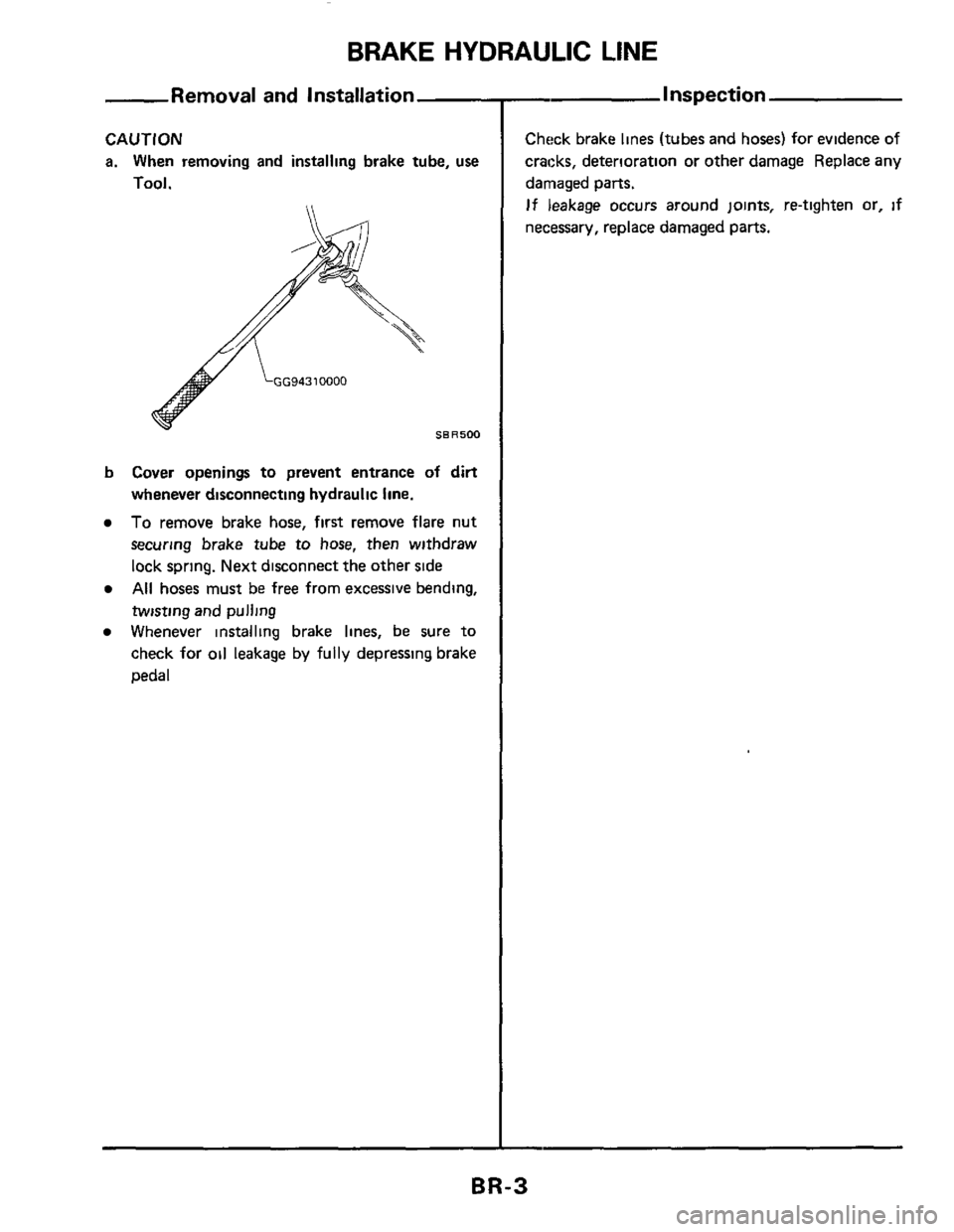
BRAKE HYDRAULIC LINE
Removal and Installation
CAUTION
a. When removing and installing brake tube, use
Tool.
b Cover openings to prevent entrance of dirt
whenever disconnecting hydraulic line.
To remove brake hose, first remove flare nut
securing brake
tube to hose, then withdraw
lock spring. Next disconnect the other side
All hoses must be free from excessive bending,
twisting and pulling
Whenever installing brake lines, be sure to
check for
oil leakage by fully depressing brake
pedal
- Inspection
Check brake lines (tubes and hoses) for evidence of
cracks, deterioration or other damage Replace any
damaged
parts.
If leakage occurs around joints, retighten or, if
necessary, replace damaged parts.
BR-3
Page 4 of 21
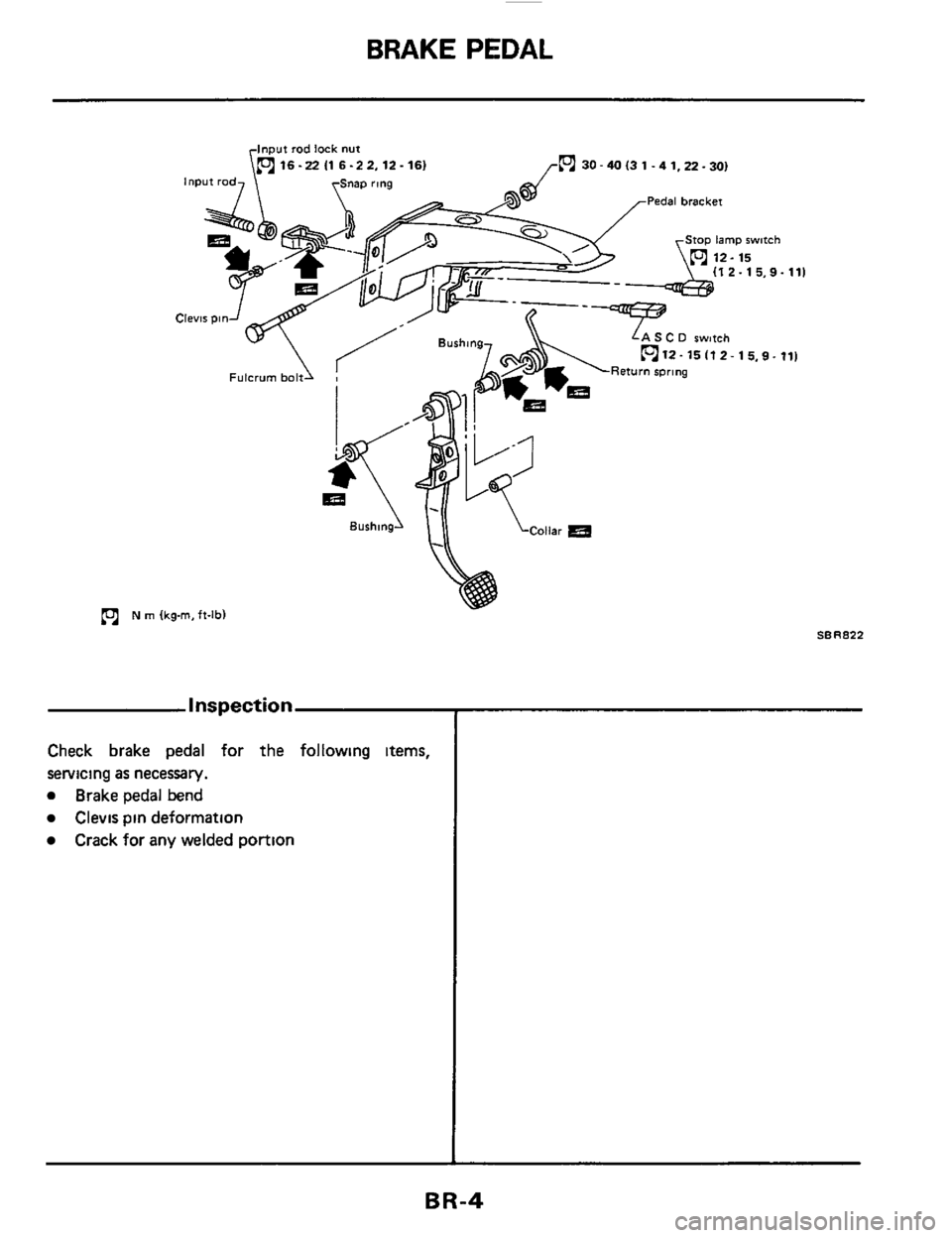
BRAKE PEDAL
Input rod lock nut
30-40 I3 1.4 1,ZZ- 30)
Pedal bracket
Stop lamp switch
I1 2. 15,9- 111
N rn lkg-m, ft-lb)
Inspection
Check brake pedal for the following items,
servicing
as necessary.
Brake pedal bend
Clevis pin deformation
Crack for any welded portion
SBR822
BR-4
Page 5 of 21
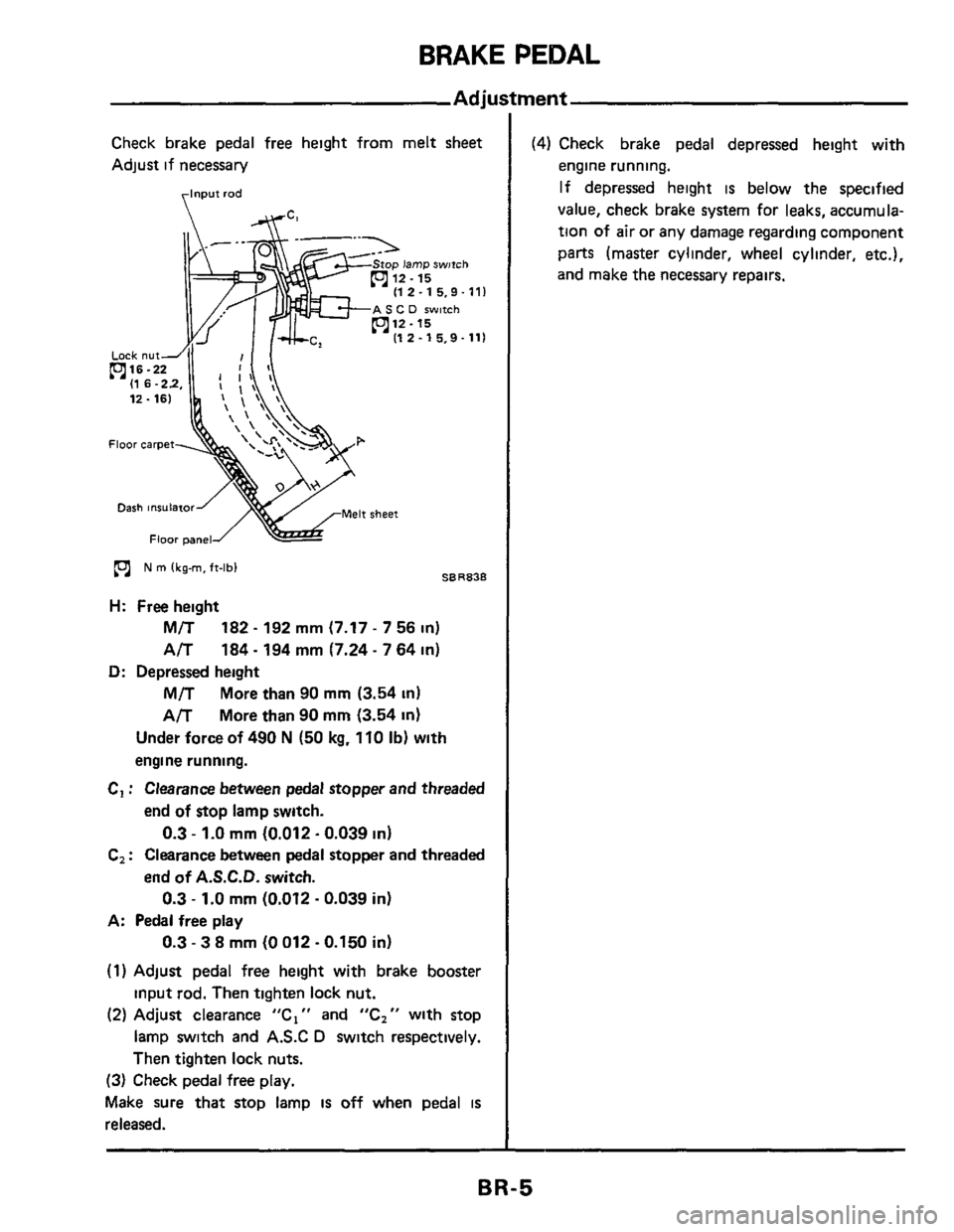
BRAKEPEDAL
Adjustment
Check brake pedal free height from melt sheet
Adjust
if necessary
I1 2.15.9- 111
AS C D switch
I /-k I1 2 - 1 5,9.111
Dash insulator
N m 1kg-m. ft-lbl
sheet
SERE38
H: Free height
M/T
A/T
D: Depressed height
M/T
A/T
I82 - 192 mm (7.17 - 7 56 in)
184 - 194 mm (7.24 - 7 64 in)
More than
90 mm (3.54 in)
More than 90 mm (3.54 in)
Under force of 490 N (50 kg. 110 Ib) with
engine running.
C, : Clearance between pedal stopper and threaded
end
of stop lamp switch.
Cz : Clearance between pedal stopper and threaded
end of A.S.C.D. switch.
0.3 - 1.0 mm (0.012 ~ 0.039 in)
0.3 - 1.0 mm (0.012 - 0.039 in)
0.3 - 3 8 mm (0 012 - 0.150 in)
A: Pedal free play
(1) Adjust pedal free height with brake booster
input rod. Then tighten lock nut.
(2) Adjust clearance "C1" and "C2" with stop
lamp switch and A.S.C
D switch respectively.
Then tighten lock nuts.
(3) Check pedal free play.
Make sure that
stop lamp is off when pedal is
released.
(4) Check brake pedal depressed height with
engine running.
If depressed height
is below the specified
value, check brake system for leaks, accumula-
tion of
air or any damage regarding component
parts (master cylinder, wheel cylinder, etc.),
and make the necessary repairs.
BR-5
Page 6 of 21
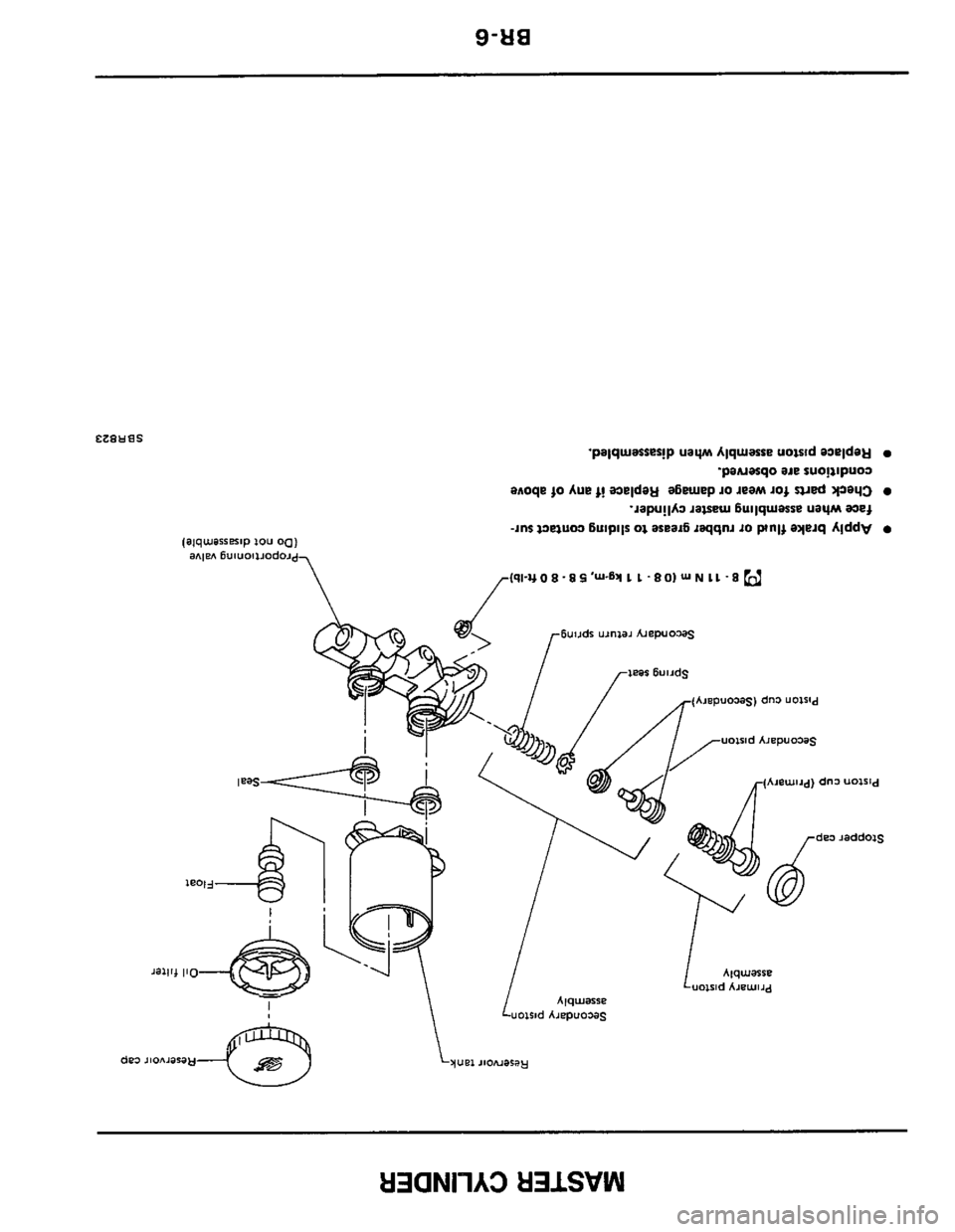
I
I
t13aNllA3 t131SVW
Page 7 of 21

BRAKE BOOSTER
Operating Check
Depress brake pedal several times with engine
off, then check that there
is not change in
pedal stroke
Depress brake pedal, then
start engine. If pedal
goes down slightly, operation
is normal
Airtight Check
Start engine, then stop it in one or two minutes.
Depress brake pedal several times slowly. If
pedal goes further down the
first time, but
gradually
rises after second or third time, the
booster
is airtight.
Depress brake pedal while engine
is running,
then stop
it with pedal depressed. If there is
no change in pedal stroke after holding pedal
for thirty seconds, brake booster
is airtight
--Removal and Installation
(9116-22 (1 6 -2 2.12.16
(91 8. 11 (0 8. 1.1,5.8.8.01 1
8 - 11 (0 8 - 1 1,5.8.8.01
SBR831 (c1 N rn (kg-m, ft-lbl
BR-7
Page 8 of 21

BRAKE BOOSTER
Inspection
HOSES AND CONNECTORS
0 Check condition of vacuum hoses and con-
0 Check vacuum hoses and check valve for air
nections.
tightness
68R832
CHECK VALVE
0 When pressure is applied to the brake booster
side of check valve and valve does not open,
replace check valve with
a new one.
Manlfold %de Brake booster ride
S8R846
OUTPUT ROD LENGTH
PV servo cannot be adjusted as output rod thread
portion
is secured by adhesive
Adjustment
INPUT ROD LENGTH
Adjust length by turning Clevis.
Length "B":
140 mm (5.51 in1
BR-8
Page 9 of 21

FRONT DISC BRAKE (CL28VA, CL28VB) - Caliper
CAUTION:
When cylinder body
IS open, do not depress brake
pedal, or piston
w~ll pop out.
1. Remove pin bolt.
SBR~
Toraue member fixing bolt- rWear indicator
2. Open cylinder body upward. Then remove pad
retainer, and Inner and outer shims
SBR825
Be careful not to damage piston boot or get oil on
rotor. Always replace shims in replacing pads.
/ / /rlnner~hm [9) 72 - 97 (7 3.9 9,53.721
Sub p~n =@ to rildlng portion
Rubber bushing
Retainer bushing Pin boot1 hetamer boot
=@ P B c IPOI~ ~utyl Cupryrill grease or rhcone-based grease Pomt =@ Rubber grease point I Always replace when disassembled (c1 N m Ikg-rn. ft-lbl
SEI3824
Page 10 of 21

FRONT DISC BRAKE (CL28VA, CL28VB) - Caliper
Removal and Installation
Remove torque member fixing bolts and brake
hose connector
SBR839
Disassembly
Push out piston with dust seal using compressed
air
SER772
Inspection
CAUTION: Use brake fluid to clean. Never
use mineral oil
CYLINDER BODY
a Check inside surface of cylinder for score, rust,
wear, damage or presence of foreign materials.
If any of the above conditions
are observed,
replace cylinder body.
Minor damage from rust of foreign materials
may be eliminated by polishing surface with
a
fine emery paper. Replace cylinder body if
necessary.
a
PISTON
Check piston for score, rust, wear, damage or
presence of foreign materials. Replace if any of
the above conditions are observed.
CAUTl ON :
Piston sliding surface IS plated. Do not polish with
emery paper even if rust
or foreign materials IS
stuck to sliding surface.
PIN, PIN BOLT, RETAINER BOOT, RUBBER
BUSHING, RETAINER BUSHING, AND
PIN
BOOT
Check for wear, cracks or other damage. Replace
if any of the above conditions are observed
0
0
Properly secure dust seal.
a
With dust seal fitted to piston, insert dust seal
into groove on cylinder body and install piston.
Pay attention to piston
seal direction.
y000t n
PlStO"
Plrron seal
ULdU
LCvlinder body SBR574
BR-10